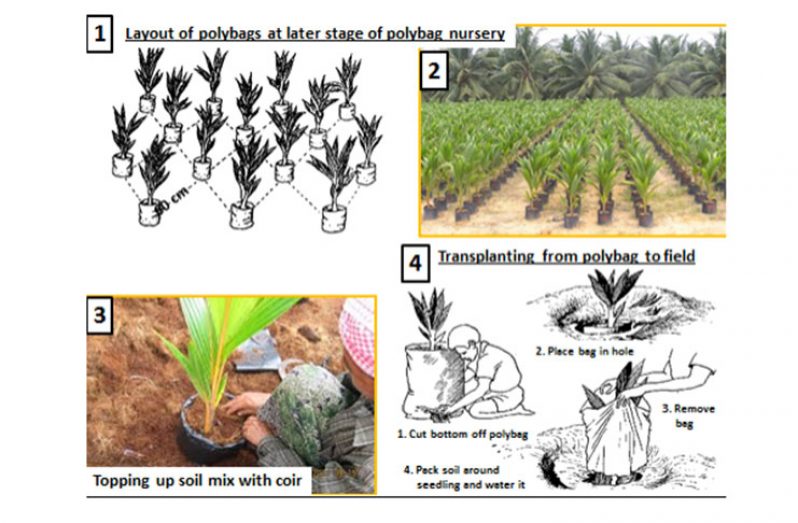Last year, the National Agricultural Research and Extension Institute (NAREI) started a series on coconut production to provide pertinent information on coconut production to help resuscitate the local coconut industry. Previous articles featured coconut varieties, germination, and nursery management. This week focus will be placed on seedling production in polybags.
Coconut seedlings can also be produced in polybags. The advantages of using polybags instead of field plots are as follows:
• Producing more vigorous seedling with better root system;
• Better establishment and early bearing;
• Transplanting shock is greatly minimized since there is no root damage, thereby promoting early establishment of transplanted seedlings;
• Seedlings can be retained longer in the nursery when conditions for field planting are not favourable;
• And, weeding, watering and elimination of unwanted seedlings as well as seedling selection for planting out to field are more easily accomplished.
However, in the Caribbean, a polybag nursery can be quite expensive (cost of media, bags, labour, and transport of bags with seedlings). This type of nursery comprises polybags (preferably black), UV resistant for durability and measuring 40 – 45 cm wide with 8 – 10 holes at bottom. The sides are half-filled with soil and compost mixed at a 50:50 ratio. Decomposed sawdust, corncobs, rice hull and other organic materials can be used so as to reduce the weight of the half-filled polybag and improve drainage and soil fertility.
In the Polybag planting method, the seednuts are pared at the top to facilitate emergence of the sprout. The nut is then placed in the half-filled bag in the upright position in the centre of the bag. Next, the bag is filled with soil with the sides slightly pressed to keep the nut firm until it is almost covered. As the soil settles, it will cover up to 2/3 of the nut.
In this method, there is no pre-nursery since the seednuts are placed directly into the polybag before they are germinated. The germinated seedlings are later picked out from the nursery once 80% of the nuts have germinated or about five months from sowing, whichever is earlier, and then laid out in the nursery.
Another method of planting in polybag requires the nuts to be sown in a pre-nursery bed. When the sprouts are 5 – 6 cm long (about 4 months after sowing), each seedling is then placed in the half-filled polybag with the sprout in an upright position in the centre of the bag. The bag is filled with soil with the sides slightly pressed to keep the nut firm until it is almost covered. In both methods, the size of a polybag nursery could be 3m x 6m with about 1.5 m spaces between plots. Each plot will easily accommodate about 115 seedlings.
At 5 – 6 months after sowing, the polybagged seedlings are laid out in a larger polybag nursery. Equal setting of the seedlings at optimum distance allows them more space to grow and develop rapidly. The technique follows a triangular system with equal spacing of 60 cm. The polybagged seedlings are set in the same order as they germinated with the earliest germinating seedlings being placed in the first row in the eastern side of the area. The last ones to germinate are placed in the western section of the area.
This practice reduces the competition for sunlight from among the earliest and latest germinating seedlings. Most importantly, selection of vigorous seedlings is facilitated and since the first pricked seedlings are placed in rows, culling or judging by age is easily accomplished.
Maintenance of polybag nursery
The same practices of watering, weeding and inspection for pest and disease incidence used in pre-nursery and field plot nursery production of seedlings are recommended. Apply 30g per bag per month of granular fertiliser (mix 1 unit urea + 2 units TSP + 2 units KCl + 1 unit MgSO₄) directly to the soil mix, in a ring around the seed nut. Afterwards, the soil is lightly cultivated to promote faster dissolution and absorption of fertiliser. Topping up the surface of the soil mix with coir can prevent weed growth and reduce evapotranspiration.




.png)









